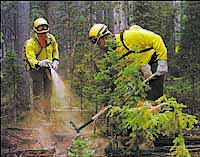 SALMON—A
turn in the weather has enabled firefighting crews around the Northwest to gain the upper
hand in controlling the worst wild land fire season in decades.
SALMON—A
turn in the weather has enabled firefighting crews around the Northwest to gain the upper
hand in controlling the worst wild land fire season in decades.
Last week, however, before snow and rain invaded Idaho, crews on the Clear
Creek Fire, near Salmon, worked around the clock to contain the blaze—at 206,379
acres, the largest forest fire in the West this summer.
 Fire
officials are now estimating that the fire will be fully contained by Sept. 30, but the
outlook was much more bleak last week. On Thursday, the fire was merely 39 percent
contained. Yesterday, that number had jumped to 75 percent.
Fire
officials are now estimating that the fire will be fully contained by Sept. 30, but the
outlook was much more bleak last week. On Thursday, the fire was merely 39 percent
contained. Yesterday, that number had jumped to 75 percent.
The firefighting effort is truly monumental.
The crews’ main base camp, called Fife Camp, is just three miles
south of Salmon and a half mile off Highway 93. It’s slightly reminiscent of a large
county fairgrounds. Port-a-potties, tents, tractor trailers, generators, around-the-clock
lighting and 1,796 firefighters and support personnel litter a 15-acre parcel of land at
the edge of the Yellowjacket Mountains. During the day, the camp is eerily empty.
 A battalion of
Marines from Camp Pendleton in California was camped out in their own tent city near Fife
Camp. They transitioned with a battalion from Camp Lejeune, near Jacksonville, N.C., over
the weekend.
A battalion of
Marines from Camp Pendleton in California was camped out in their own tent city near Fife
Camp. They transitioned with a battalion from Camp Lejeune, near Jacksonville, N.C., over
the weekend.
 According
to Clear Creek Fire information officer Walt Sixkiller, the fire had cost taxpayers $39.2
million by Thursday.
According
to Clear Creek Fire information officer Walt Sixkiller, the fire had cost taxpayers $39.2
million by Thursday.
"We are making a little progress," Sixkiller said Thursday.
During hot, dry conditions, progress consists of containing the fire
rather than extinguishing it. Firefighters construct fire lines, or breaks, which the fire
should not be able to cross.
 On Thursday,
firefighters on the northeast front of the Clear Creek fire worked to hold a fire line
that had been established several days before. On the south side of the fire break, which
was about 120 feet wide, the ground was charred and trees were blackened monuments to the
ravaging flames that had drained the life from them.
On Thursday,
firefighters on the northeast front of the Clear Creek fire worked to hold a fire line
that had been established several days before. On the south side of the fire break, which
was about 120 feet wide, the ground was charred and trees were blackened monuments to the
ravaging flames that had drained the life from them.
 Smoke and
spot fires sprung from fallen trees, stumps and patches of grass. Firefighters walked and
drove the line, extinguishing encroaching spot fires as they went. Helicopters and
airplanes flew overhead, dropping fire retardant on blazing flames and spewing smoke no
more than 200 yards from the fire break.
Smoke and
spot fires sprung from fallen trees, stumps and patches of grass. Firefighters walked and
drove the line, extinguishing encroaching spot fires as they went. Helicopters and
airplanes flew overhead, dropping fire retardant on blazing flames and spewing smoke no
more than 200 yards from the fire break.
 The aura of
the place was not too unlike that of a war zone, several firefighters commented.
The aura of
the place was not too unlike that of a war zone, several firefighters commented.
The north side of the fire break appeared green and lush, deceiving
onlookers about the tinder-dry conditions that actually persisted.
For several firefighters, it was their first time in Idaho, and for many
of the Marines, it was their first time fighting fires.
"It was hot—a new experience," John Capes, a Marine from
Camp Pendleton, said as he waited on Salmon’s main street to get money from an ATM.
Henry Hasselhan, a volunteer firefighter from New Jersey, said dealing
with sporadic winds has been one of the biggest challenges on the Clear Creek Fire. He was
lounging on the back of a fire truck he was working on to extinguish spot fires on the
northeast front of the fire.
"Since I’ve been here, the winds have done what they’re
going to do when they want to do it," Hasselhan said.
As Sixkiller drove several of the fire’s borders on dusty and rocky
dirt roads, he pointed out that, in many areas, the fire hasn’t killed some trees or
patches of grass.
But the blaze will be enough to prevent fires from burning in the area for
some time to come, he said. "This’ll last for a lot of years, now."